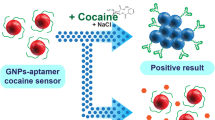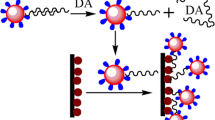Abstract
Heroin, marijuana and cocaine are widely abused drugs. Their use can be readily detected by analyzing urine for the metabolites morphine (MOR), tetrahydrocannabinol (THC) or benzoylecgonine (BZC). A multiplex immunosensor is described here for detection of MOR, THC and BZC using screen printed carbon array electrodes modified with gold nanoparticles. Antibodies against MOR, THC and BZC were immobilized on eight electrodes in a sensor array simultaneously, and a competitive assay was used for the detection. The free analytes in the sample compete with bovine serum albumin-conjugated analytes for the immobilized antibodies on the sensor surface. The array is capable of detecting the three drugs simultaneously within 20–40 min. The method has a high sensitivity, with detection limits as low as 1.2, 7.0, and 8.0 pg.mL−1 for MOR, THC and BZC, respectively. Cross reactivity testing was preformed to monitor any nonspecific binding. The results revealed good selectivity. Urine samples were spiked with the 3 drugs and tested with the multiplexed immunosensor. Recovery percentages ranged between 88 to 115%.

Schematic presentation of the multiplexed immunosensor for drugs of abuse,viz. tetrahydrocannabinol (THC), morphine (MOR), and benzoylecgonine (BZC)) by using an array of modified electrodes.






Similar content being viewed by others
References
Xiao D, Jiang Y, Bi Y (2018) Molecularly imprinted polymers for the detection of illegal drugs and additives: a review. Microchim Acta 185(4):247. https://doi.org/10.1007/s00604-018-2735-4
Cherubin CE, Sapira JD (1993) The medical complications of drug addiction and the medical assessment of the intravenous drug user: 25 years later. Ann Intern Med 119(10):1017–1028
Büttner A (2011) Review: the neuropathology of drug abuse. Neuropathol Appl Neurobiol 37(2):118–134. https://doi.org/10.1111/j.1365-2990.2010.01131.x
World Drug Report (2015) UNITED NATIONS New York
Strano-Rossi S, Molaioni F, Rossi F, Botrè F (2005) Rapid screening of drugs of abuse and their metabolites by gas chromatography/mass spectrometry: application to urinalysis. Rapid Commun Mass Spectrom 19(11):1529–1535. https://doi.org/10.1002/rcm.1942
Jamwal R, Topletz AR, Ramratnam B, Akhlaghi F (2017) Ultra-high performance liquid chromatography tandem mass-spectrometry for simple and simultaneous quantification of cannabinoids. J Chromatogr B 1048:10–18. https://doi.org/10.1016/j.jchromb.2017.02.007
Chiuminatto U, Gosetti F, Dossetto P, Mazzucco E, Zampieri D, Robotti E, Gennaro MC, Marengo E (2010) Automated online solid phase extraction ultra high performance liquid chromatography method coupled with tandem mass spectrometry for determination of forty-two therapeutic drugs and drugs of abuse in human urine. Anal Chem 82(13):5636–5645. https://doi.org/10.1021/ac100607v
Ary K, Róna K (2001) LC determination of morphine and morphine glucuronides in human plasma by coulometric and UV detection. J Pharm Biomed Anal 26(2):179–187. https://doi.org/10.1016/S0731-7085(01)00393-4
Zgair A, Wong JCM, Sabri A, Fischer PM, Barrett DA, Constantinescu CS, Gershkovich P (2015) Development of a simple and sensitive HPLC–UV method for the simultaneous determination of cannabidiol and Δ9-tetrahydrocannabinol in rat plasma. J Pharm Biomed Anal 114:145–151. https://doi.org/10.1016/j.jpba.2015.05.019
Barnett NW, Lewis SW, Tucker DJ (1996) Determination of morphine in process streams by sequential injection analysis with chemiluminescence detection. Fresenius J Anal Chem 355(5):591–595. https://doi.org/10.1007/s0021663550591
Pulgarín JAM, Bermejo LFG, Gallego JML, García MNS (2008) Simultaneous stopped-flow determination of morphine and naloxone by time-resolved chemiluminescence. Talanta 74(5):1539–1546. https://doi.org/10.1016/j.talanta.2007.09.032
Agius R, Nadulski T, Moore C (2012) Validation of LUCIO®-direct-ELISA kits for the detection of drugs of abuse in urine: application to the new German driving licence re-granting guidelines. Forensic Sci Int 215(1):38–45. https://doi.org/10.1016/j.forsciint.2011.10.034
Carrio A, Sampedro C, Sanchez-Lopez JL, Pimienta M, Campoy P (2015) Automated low-cost smartphone-based lateral flow saliva test reader for drugs-of-abuse detection. Sensors (Basel, Switzerland) 15(11):29569–29593. https://doi.org/10.3390/s151129569
Guler E, Yilmaz Sengel T, Gumus ZP, Arslan M, Coskunol H, Timur S, Yagci Y (2017) Mobile phone sensing of cocaine in a lateral flow assay combined with a biomimetic material. Anal Chem 89(18):9629–9632. https://doi.org/10.1021/acs.analchem.7b03017
Caslavska J, Allemann D, Thormann W (1999) Analysis of urinary drugs of abuse by a multianalyte capillary electrophoretic immunoassay. J Chromatogr A 838(1):197–211. https://doi.org/10.1016/S0021-9673(99)00115-6
Choi J, Kim C, Choi MJ (1998) Comparison of capillary electrophoresis-based immunoassay with fluorescence polarization immunoassay for the immunodetermination of methamphetamine using various methamphetamine antibodies. ELECTROPHORESIS 19 (16–17):2950–2955. https://doi.org/10.1002/elps.1150191626
Singh S, Mishra P, Banga I, S Parmar A, Prakash Tripathi P, Gandhi S (2018) Chemiluminescence based immunoassay for the detection of heroin and its metabolites. BioImpacts : BI 8 (1):53–58. https://doi.org/10.15171/bi.2018.07
Hazarika P, Jickells SM, Wolff K, Russell DA (2010) Multiplexed detection of metabolites of narcotic drugs from a single latent fingermark. Anal Chem 82(22):9150–9154. https://doi.org/10.1021/ac1023205
Gandhi S, Caplash N, Sharma P, Raman Suri C (2009) Strip-based immunochromatographic assay using specific egg yolk antibodies for rapid detection of morphine in urine samples. Biosens Bioelectron 25(2):502–505. https://doi.org/10.1016/j.bios.2009.07.018
Li F, Song J, Shan C, Gao D, Xu X, Niu L (2010) Electrochemical determination of morphine at ordered mesoporous carbon modified glassy carbon electrode. Biosens Bioelectron 25(6):1408–1413. https://doi.org/10.1016/j.bios.2009.10.037
Wanklyn C, Burton D, Enston E, Bartlett C-A, Taylor S, Raniczkowska A, Black M, Murphy L (2016) Disposable screen printed sensor for the electrochemical detection of delta-9-tetrahydrocannabinol in undiluted saliva. Chemistry Central Journal 10(1). https://doi.org/10.1186/s13065-016-0148-1
Ensafi AA, Heydari-Bafrooei E, Rezaei B (2013) Different interaction of codeine and morphine with DNA: a concept for simultaneous determination. Biosens Bioelectron 41:627–633. https://doi.org/10.1016/j.bios.2012.09.039
Talemi RP, Mashhadizadeh MH (2015) A novel morphine electrochemical biosensor based on intercalative and electrostatic interaction of morphine with double strand DNA immobilized onto a modified au electrode. Talanta 131:460–466. https://doi.org/10.1016/j.talanta.2014.08.009
Navaee A, Salimi A, Teymourian H (2012) Graphene nanosheets modified glassy carbon electrode for simultaneous detection of heroine, morphine and noscapine. Biosens Bioelectron 31(1):205–211. https://doi.org/10.1016/j.bios.2011.10.018
Li Y, Zou L, Li Y, Li K, Ye B (2014) A new voltammetric sensor for morphine detection based on electrochemically reduced MWNTs-doped graphene oxide composite film. Sensors Actuators B Chem 201:511–519. https://doi.org/10.1016/j.snb.2014.05.034
Chantada-Vázquez MP, Sánchez-González J, Peña-Vázquez E, Tabernero MJ, Bermejo AM, Bermejo-Barrera P, Moreda-Piñeiro A (2016) Simple and sensitive molecularly imprinted polymer – Mn-doped ZnS quantum dots based fluorescence probe for cocaine and metabolites determination in urine. Anal Chem 88(5):2734–2741. https://doi.org/10.1021/acs.analchem.5b04250
Weng C-H, Yeh W-M, Ho K-C, Lee G-B (2007) A microfluidic system utilizing molecularly imprinted polymer films for amperometric detection of morphine. Sensors Actuators B Chem 121(2):576–582. https://doi.org/10.1016/j.snb.2006.04.111
Kriz D, Mosbach K (1995) Competitive amperometric morphine sensor based on an agarose immobilised molecularly imprinted polymer. Anal Chim Acta 300(1):71–75. https://doi.org/10.1016/0003-2670(94)00368-V
Yeh W-M, Ho K-C (2005) Amperometric morphine sensing using a molecularly imprinted polymer-modified electrode. Anal Chim Acta 542(1):76–82. https://doi.org/10.1016/j.aca.2005.01.071
Zhang C, Han Y, Lin L, Deng N, Chen B, Liu Y (2017) Development of quantum dots-labeled antibody fluorescence immunoassays for the detection of morphine. J Agric Food Chem 65(6):1290–1295. https://doi.org/10.1021/acs.jafc.6b05305
Ya Y, Xiaoshu W, Qing D, Lin J, Yifeng T (2015) Label-free immunosensor for morphine based on the electrochemiluminescence of luminol on indium–tin oxide coated glass functionalized with gold nanoparticles. Anal Methods 7(11):4502–4507. https://doi.org/10.1039/c5ay00764j
Munoz EM, Lorenzo-Abalde S, González-Fernández Á, Quintela O, Lopez-Rivadulla M, Riguera R (2011) Direct surface plasmon resonance immunosensor for in situ detection of benzoylecgonine, the major cocaine metabolite. Biosens Bioelectron 26(11):4423–4428. https://doi.org/10.1016/j.bios.2011.04.056
Sakai G, Ogata K, Uda T, Miura N, Yamazoe N (1998) A surface plasmon resonance-based immunosensor for highly sensitive detection of morphine. Sensors Actuators B Chem 49(1):5–12. https://doi.org/10.1016/S0925-4005(98)00107-5
Munge BS, Stracensky T, Gamez K, DiBiase D, Rusling JF (2016) Multiplex Immunosensor arrays for electrochemical detection of Cancer biomarker proteins. Electroanalysis 28(11):2644–2658. https://doi.org/10.1002/elan.201600183
Eissa S, Alshehri N, Abduljabbar M, Rahman AMA, Dasouki M, Nizami IY, Al-Muhaizea MA, Zourob M (2018) Carbon nanofiber-based multiplexed immunosensor for the detection of survival motor neuron 1, cystic fibrosis transmembrane conductance regulator and Duchenne muscular dystrophy proteins. Biosens Bioelectron 117:84–90. https://doi.org/10.1016/j.bios.2018.05.048
Yu A, Liang Z, Cho J, Caruso F (2003) Nanostructured electrochemical sensor based on dense gold nanoparticle films. Nano Lett 3(9):1203–1207. https://doi.org/10.1021/nl034363j
Eissa S, Zourob M (2017) Competitive voltammetric morphine immunosensor using a gold nanoparticle decorated graphene electrode. Microchim Acta 184(7):2281–2289. https://doi.org/10.1007/s00604-017-2261-9
Author information
Authors and Affiliations
Corresponding author
Ethics declarations
The author(s) declare that they have no competing interests.
Additional information
Publisher’s note
Springer Nature remains neutral with regard to jurisdictional claims in published maps and institutional affiliations.
Rights and permissions
About this article
Cite this article
Eissa, S., Almthen, R.A. & Zourob, M. Disposable electrochemical immunosensor array for the multiplexed detection of the drug metabolites morphine, tetrahydrocannabinol and benzoylecgonine. Microchim Acta 186, 523 (2019). https://doi.org/10.1007/s00604-019-3646-8
Received:
Accepted:
Published:
DOI: https://doi.org/10.1007/s00604-019-3646-8




